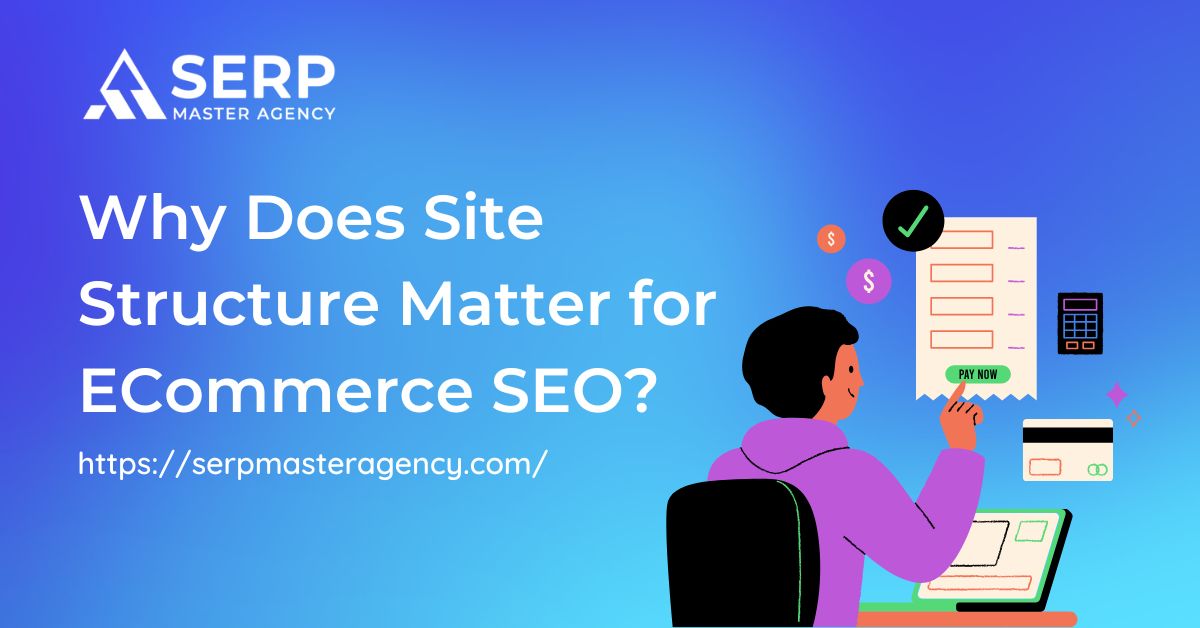Think of your online store like a supermarket. Imagine walking into a store where items are scattered randomly—milk is hidden behind electronics, and snacks are nowhere to be found. You’d probably leave and find another store, right?
That’s what a poor website structure feels like to both shoppers and search engines. Site structure is how your website’s pages are organised and linked together.
It helps users find what they’re looking for and allows search engines to crawl and index your content properly.
For ECommerce businesses, having the right site structure can make a big difference in search visibility, user experience, and conversions. Let’s look at why structure plays such a key role in ECommerce SEO.
What Is Site Structure in ECommerce?
A Simple Explanation
Site structure refers to the way your website’s pages are arranged and connected. Think of it like the layout of a well-organised grocery store.
The main aisles have signs like “Dairy,” “Snacks,” and “Bakery,” with clearly marked sections beneath each. A customer can easily navigate and find what they want.
On a website, this structure starts from the homepage and branches into categories, subcategories, and finally individual product pages.
If this layout is logical and clean, it becomes easier for both visitors and search engines to use the site.
Tools like SERP Boosters often rely on this structure to help improve crawlability, indexing, and search performance.
Core Components
A typical ECommerce website starts with a homepage that links to key product categories. These categories might include things like clothing, electronics, or home goods.
Each category can then lead to more specific subcategories, like men’s jackets or Bluetooth speakers. Finally, these subcategories lead to individual product pages.
All these pages are connected using navigation menus, internal links, and breadcrumb trails. Internal links also connect related products, blog posts, or FAQs to help guide visitors through the site without confusion.
This kind of organisation helps create a clear path from any entry point on your site to a conversion point, such as a product purchase or contact form.
How Site Structure Impacts Search Engine Rankings
Helps Google Understand Your Website
Search engines use bots to crawl websites and understand what they’re about. These bots follow links from one page to another, trying to make sense of your content and determine which pages should appear in search results.
If your site is structured clearly, the bots can move through it smoothly and discover every important page.
But if your structure is messy—with broken links, duplicate pages, or confusing categories—search engines might miss important content or misunderstand what your site offers.
Having a clean, logical structure helps search engines index your site more completely and rank your pages more accurately.
Boosts Keyword Visibility
Every page on your site is an opportunity to rank for different search terms. For example, a category page might target general keywords like “wireless headphones,” while a product page might rank for more specific terms like “Bluetooth noise-cancelling headphones.”
A clear structure helps you assign keywords to the right pages without overlap. It also allows you to create keyword-rich URLs and metadata for each section of your store.
A professional SEO Company often focuses heavily on improving structure because they know how important it is for keyword performance.
When every page has a purpose and a place, your site becomes more visible in search engines.
Improves User Experience and Reduces Bounce Rate
Easier Navigation for Shoppers
When people land on your site, they should immediately understand where they are and how to get to what they want.
A strong site structure supports this by using clear menus, filters, and breadcrumbs to guide them.
Breadcrumbs help users track their location on your site and go back easily if needed.
Category pages should be easy to scan, and search functions should return relevant results. All these elements work together to make navigation simple and stress-free.
Keeps People on the Page
If users can’t find what they need quickly, they’re likely to leave. That’s called a bounce—and high bounce rates tell search engines that your site may not be helpful or engaging.
On the other hand, a structured site keeps people exploring. When a visitor clicks through multiple pages, views related items, or adds products to their cart, it signals to search engines that your content is useful. This kind of positive engagement supports higher rankings over time.
Strengthens Internal Linking Strategy
Spreads Link Authority
Search engines consider internal links when evaluating the importance of a page. When strong pages link to others, they pass on “link equity” or ranking power.
If your homepage links to a popular category, which in turn links to several product pages, that power flows throughout the structure.
This internal link strategy helps newer or deeper pages get noticed. It’s a common method used by any skilled SEO Company to lift visibility across the entire website—not just the homepage.
Guides Customers to Related Products
Internal linking isn’t just good for SEO—it’s also great for user experience. When visitors are browsing a product, links to related items, accessories, or bundles can keep them engaged and help them make informed decisions.
For example, someone looking at a laptop might also see links to cases, keyboards, or software.
This encourages deeper browsing, potentially increases order size, and keeps the user moving through your site.
Supports Scalability of Your ECommerce Business
Easier to Add New Products or Categories
A clear site structure helps your store grow efficiently and sustainably. As you expand your product range or introduce new categories, you won’t need to overhaul your website or spend extra time reorganising pages.
Instead, you can simply insert new items into the correct sections without disrupting the user experience.
This type of flexibility is especially valuable for growing online businesses that want to stay agile.
Well-organised categories and subcategories allow you to group products logically, while tags and attributes make it easier to filter and sort results for customers.
A solid structure also supports every aspect of your ECommerce SEO Service, ensuring that new pages can be optimised quickly and indexed properly by search engines.
In the long run, this creates a scalable foundation that keeps your store SEO-friendly even as it grows.

Prevents Technical SEO Issues
Sites with poor structure often suffer from technical problems like broken links, orphan pages, or duplicate content.
Orphan pages are pages that no other page links to, making them almost invisible to users and search engines.
A solid structure helps prevent these issues by keeping all pages connected and in their proper place.
This reduces the need for frequent fixes and helps your site run more smoothly in the long term.
Common Site Structure Mistakes to Avoid
Flat vs. Deep Architecture
A flat site structure means every page is only one or two clicks away from the homepage. This can be helpful for crawling but becomes unmanageable as the site grows.
Everything ends up cluttered and difficult to organise.
A deep structure, on the other hand, requires users to click many times to reach the content they want. This can frustrate users and hide important pages from search engines.
The best solution is a balanced structure—deep enough to group similar content but flat enough to keep important pages accessible.
Broken Links and Orphan Pages
A broken link leads to a page that no longer exists. It’s frustrating for users and can damage your SEO if search engines keep running into dead ends.
Orphan pages are another common issue. These are pages that are published but not linked anywhere else on the site. Since users and crawlers can’t find them easily, they don’t help your SEO or conversions.
These issues often result from poor planning or lack of regular updates. But a well-thought-out structure makes them less likely to occur in the first place.
Conclusion
A smart and simple site structure does more than just look neat—it supports your store’s growth, improves the shopping experience, and boosts your performance in search results.
It helps search engines understand what your store sells and helps shoppers find what they’re looking for faster.
Whether you’re launching a new site or improving an existing one, investing in a strong site structure will pay off in both traffic and conversions.
At SERP Master Agency, we help online businesses build structured, SEO-friendly websites that grow with them. From homepage to product page, every layer of your site should serve a purpose—for both users and search engines.
If you want your ECommerce store to work smarter and rank better, start with your site structure. It’s the foundation for everything else.

Suraj Rana is a highly regarded SEO expert specializing in the dental industry. His expertise lies in crafting strategic SEO marketing plans to help new or expanding businesses increase their online visibility and attract more customers. Suraj Rana’s skills extend to improving website rankings and boosting organic search visibility, thereby enhancing web traffic and return on investment for businesses.



